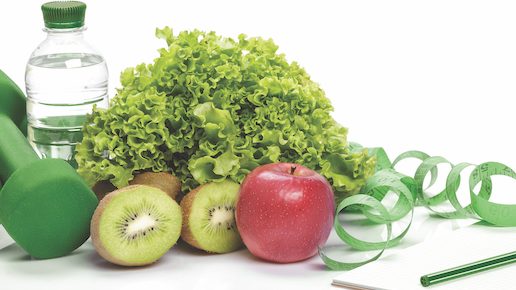
By Joy Gregory
Your knees hurt, your back aches and when you walk too fast you have to take a break to catch your breath. It’s just part of getting older, especially when your work puts tough, physical demands on your body, right?
Not so fast, say two health professionals who help people improve the way they move, eat, sleep and think. Our bodies are complex, multi-faceted machines and good health means more than just a fit body. Here’s their advice.
BUILD YOUR HEALTH ACCOUNT

Brooke Bulloch is a registered dietitian and the CEO of Food to Fit Nutrition. She suggests people think differently about what they eat. Instead of looking at what you should cut from your diet, Bulloch says to look at what you should add to your diet to improve your particular markers of health such as lower cholesterol or blood sugar levels.
Lisa Workman is a clinical exercise physiologist (CEP). Based in Edmonton, she’s part of a multi-disciplinary team that includes medical doctors, dietitians and social workers. While physiotherapists focus on rehab after injury, CEPs provide exercise training with therapeutic benefits for people with chronic diseases such as arthritis, diabetes and high blood pressure. A doctor might tell you why you need to exercise, a CEP helps with the how and why.
With last year’s crop sold or in the bin, Workman suggests that farm folks use winter as a kind of pre-season training camp. But you can forget the “no pain no gain” approach to exercise. Workman’s number one tip is move, then move more. Research shows people benefit from 150 minutes of moderate to intense cardiovascular exercise a week, but those minutes can be divided into intervals — and walking counts.
While a CEP can help you learn how to get the most from cardio and resistance (weights) training, you have to put in the time to reap the benefits. Workman understands that farmers are tired after a long day in the tractor or at their desks. Still, she insists that’s when they need to add something as simple as a 15-minute walk to their day. Over time, this extra movement puts energy in your tank. It’s also likely to help you sleep better and think more clearly.
Brooke Bulloch applies the same practical approach to nutrition. A registered dietitian in Saskatoon and the CEO of Food to Fit Nutrition, Bulloch wants people to think differently about what they eat. Knowing that shame and blame do not motivate change, Bulloch steers away from the good food/bad food dichotomy. Instead of talking about what people should cut, she helps clients learn what they can add to their diets to improve measurable health markers, like lower cholesterol and blood sugar levels.
To improve markers of health, Bulloch teaches clients how to add fibre-rich foods, like fruit, vegetables, pulses and nuts to their diet. Fibre helps to slow digestion creating a longer lasting and more filling meal. It also helps prevent the physical and mental energy drops associated with more drastic declines in blood sugar.
When measuring the impact of dietary changes, Bulloch assesses blood markers and changes to energy levels, mental health, sleep habits and gastro-intestinal issues, all of which are linked to health and quality of life.
SCIENCE, NOT MAGIC
The health benefits of movement are proven, says Workman. While blood pressure rises during cardio, that impact is temporary. “A single session of cardio exercise dilates the blood vessels in your body and that dilation naturally brings blood pressure down,” she explains. There is evidence that resistance training also lowers blood pressure.

Strong bodies are also less prone to injury. That’s important for farm folks to remember, since injury avoidance improves the quality of your work life and prepares people to enjoy a healthy retirement.
LISA WORKMAN CLINICAL EXERCISE PHYSIOLOGIST
Regular exercise improves heart health issues complicated by the hormonal changes associated with menopause, adds Workman. Remember: heart disease is the number one killer of women, mostly in that post-menopausal stage of life.
Movement also helps with the symptoms of osteoarthritis, a common cause of joint inflammation and pain. “When we contract our muscles around our joints, it gives us extra lubrication into that joint,” says Workman.
“We know the physiological implications of exercise on blood sugar, which is an issue with type 2 diabetes. One single session of cardio or resistance training is going to help drop that blood sugar level, which benefits cardiovascular health,” she says. “The thicker the blood gets with more blood sugar, the harder it is for the heart to push the blood through itself and you run a higher risk of a cardiac event.”
High levels of blood sugar also have a negative effect on eye health and are linked to pain, weakness and numbness, typically in the feet. Known as neuropathy, this pain can lead to problems walking.
“We have strong evidence that exercise reduces the risk of breast cancer and colorectal cancer, too,” says Workman. Strong bodies are also less prone to injury. That’s important for farm folks to remember, since injury avoidance improves the quality of your work life and prepares people to enjoy a healthy retirement, she says.
So how do you get your own improved health ball rolling? Reach out, say Workman and Bulloch. While it’s relatively easy to learn what you can do to make your body stronger, the best training camps are led by skilled professionals.